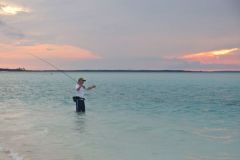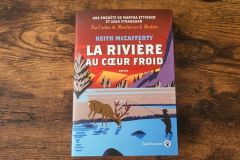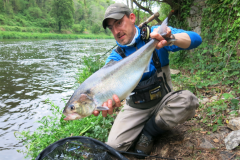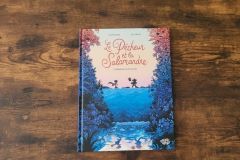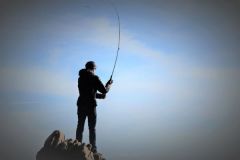Hello Jérôme, could you introduce yourself to our readers?
Hello Laurent, and thank you for this interview. I'm Jérôme Magnier-Moreno, fly fisherman, writer and painter (under the name Rorcha). These three identities give me very different but mutually enriching experiences. The triptych painting-fishing-writing is a bit like my ecosystem...
How long have you been fishing and what does it mean to you?
My first fishing trips go back a long way to childhood, when a beautiful little river in the Oise âeuros la Nonette âeuros (which feeds the basins of the Chantilly château), ran through my grandparents' garden. As soon as I could hold a fishing rod, my father showed me how to catch roach. During the summer vacations, when the light was fading to orange and the birds were chirping in the trees, it was a magical time when my father and I would fish for chub, gudgeon, bream and roach, one by one, with simple bamboo rods and a tiny bread crumb attached to the hook.
In the evening, as I closed my eyes in bed, I could still see the fine colored corks drifting in the current before suddenly sinking below the surface of the water, signaling the long-awaited "touch". That's how my vocation as a fisherman was born, in the wonder of that river and through that precious filial bond forged around fishing that I evoke in my latest novel Highlands.
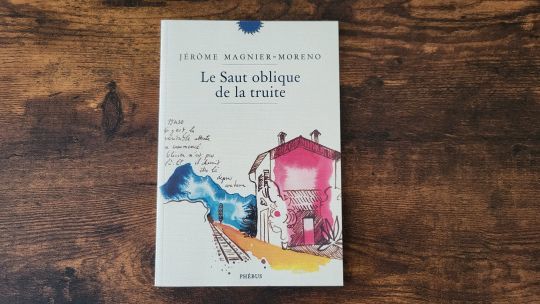
Generally speaking, I've always found fishing to have a wonderful and varied initiatory dimension: thanks to it, we discover a direct, almost animal link to nature and its landscapes, which we understand intuitively through observation; it also leads us to travel to new regions, new countries and to make new fishing buddies. Finally, it's no doubt partly my love of fishing that has led me to read the great writers of wilderness and rivers, including Hemingway, Thoreau, Harrison, Maupassant, Genevoix and Bosco (in French literature), but it would be unfair not to mention Norman MacLean, John Gierach, Richard Brautigan and so many others who have expressed their passion for fishing in words.
Your books and your work are related to fishing. Can you tell us more about this professional path?
During the many childhood vacations I spent in the Oise, I not only developed a passion for pike and cyprinid fishing, but for the river as a whole, its valley, its landscapes, its flora and fauna. So much so, that when it came to choosing a direction for my studies, the profession of landscape architect seemed precisely "natural".
At the École Nationale Supérieure du Paysage de Versailles, my diploma thesis 25 years ago proposed the creation of a new profession, that of "river landscaper"; and if the discovery of painting hadn't interrupted this impetus, I think it would have been a specialization as interesting as it was useful: today's challenges of soil pollution, increasingly catastrophic floods or, on the contrary, the increasing scarcity of water, testify to the urgency of rethinking rivers and their watersheds.
But in the end, I chose to paint, which of course didn't stop the aquatic theme from establishing itself as one of my favorite subjects. Fish, rivers, lakes, reflections on water, water lilies - I've explored all these oh-so-pictorial themes in turn over the last twenty-five years, and even when from time to time my painting has become more abstract, the current of the River has always continued to irrigate my compositions.
My most recent and most abundant series on a single theme was devoted to the lakes of Scotland, which I painted between 2017 and 2024. During this period, I also wrote the novel Highlands, also set in Scotland. It was this dual approach, both pictorial and literary, that gave rise to this illustrated novel, published last May by Éditions Gallimard in the Le sentiment géographique collection.
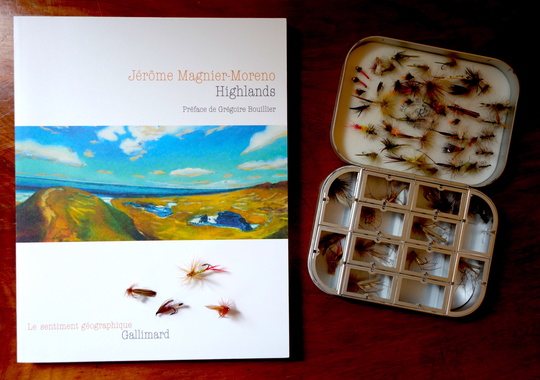
Why are fishing and travel so closely linked in your books?
After discovering the first river of my childhood, I had to leave this enclosed Garden of Eden and set off to discover the wide world, especially since the family property had unfortunately been sold. The good news was that there were superb rivers everywhere âeuros even more spectacular and transparent and full of fish than little Nonette âeuros I soon realized...
Travelling in search of these new fishing grounds was for me a powerful motor for exploration and even emancipation, a kind of Ariadne's thread towards adult life. Examples include the Saguenay River and its salmon in Quebec, the Dordogne, its trout and grayling at Argentat in Corrèze, and the lakes and rivers of northern Scotland described in my latest novel. As my travels progressed, each new river I visited pushed back the boundaries of the universe a little further in my mind, and I've always had the feeling that I only really know a country once I've fished in one of its rivers.
All this no doubt explains why I like to evoke initiatory adventures in my writings, where my main characters, leaving the comfort zone of their sad routine, flee to new horizons, focusing their thirst for adventure on a particular river or lake. Somehow, the call of fishing and nature rescues them from the daily grind that threatens to engulf them, and suddenly their geographical and mental horizons broaden â?" the world becomes once again, in their eyes âeuros, and I hope in those of âeuros readers, a place worth traveling to, exploring, and sinning over...
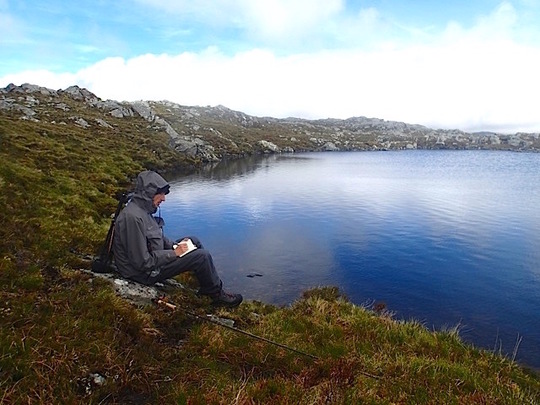
Do you have one or more fishing anecdotes to share with our readers?
One of my most vivid fishing memories will undoubtedly be the day, or rather the night, when I was fifteen and caught my first pike. For some time now, I'd been fed up with the simple roach fishing my father had taught me; I wanted more! But I knew that the Nonette was also populated by pike. So I began reading and re-reading my precious green bible La pêche, by Jérôme Nadeau, published by Larousse (we were still a long way from Internet "tutorials"...), and the chapter dealing with the different ways of catching this famous fish with the ominous Latin name of Esox Lucius.
During this self-taught period, the suspense only grew. I would dream and nightmare of pike as bloodthirsty "river wolves", and the pictures in books and magazines, zooming in on their prognathic jaws and 700 teeth, would haunt me during the endless college days. At first, however, nothing happened. Spoon fishing only landed me a few perch, so I began to explore the live-fishing technique, which finally gave me encouraging results: on several occasions, I found my roach half-severed. The way they were sliced clean through was impressive: a big pike with seven hundred teeth was on the prowl, and it looked formidable...
One evening, when I had left a line on the pontoon with two triple hooks on it (my Larousse calls it "Jardine"), and was closing the shutters in my bedroom before going to bed, I suddenly heard the brake on the reel whirring in the distance. Thirty years later, I still remember the startling screech of the line as it sped off, and the stairs of the house as I descended four at a time, heading for the river. By the time I reached it, shivering in the darkness, the pike had already travelled at least a hundred metres down the river, biting straight downstream. Grabbing hold of the rod and locking the line, I could see the splashes of the beast stopped in its tracks in the dark, milky distance. I had to patiently reel in the monster âeuros praying unceasingly that the line wouldn't break âeuros giving it more slack when, each time I thought it had been defeated, the pike took off again like a rocket, risking taking everything with it. It may have taken me a quarter of an hour of fever and adrenalin to bring him back to the bridge where, capsizing on his long white belly, he let himself be tipped into my grandfather's reel.
This magnificent pike measured 80 cm and weighed 4 kg. I don't think I've ever been prouder in my life than I was that night.
Any fishing dreams in particular?
In the truest sense of the word, I often dream of fishing and rivers, and more particularly of this dear Nonette, which I continue to walk along in my nights, as a fisherman or a simple walker, as if I'd never left it. Pikes, gandoises and goujons are always there... I find it quite astonishing how faithful my unconscious is to this place, especially as with each new dream, the landscape evolves as if it were still subject to the time and weather of the real world, as if it underwent the change of seasons or this or that development by unknown local residents... In the end, I dream like a painter, "in series", never tiring of playing with the variations of a single motif.
As for a dream in the sense of a "wish", I think the most beautiful and wildest would be that of the ecological restoration of rivers in France and elsewhere. But the many problems I described back in 2000 in my landscaping dissertation (which were themselves already some fifty years old) still seem sadly topical, and have even worsened with climate change. But since I'm a natural optimist, I'm more inclined to remember the recent example of the spectacular improvement in the quality of the Seine to accommodate the open-water swimming events of the Paris Olympic Games, which seems to prove that political will is a determining factor... Let's hope that this kind of far-reaching action will set new standards, so that the children of the future can continue to fish with their parents on the banks of rivers!
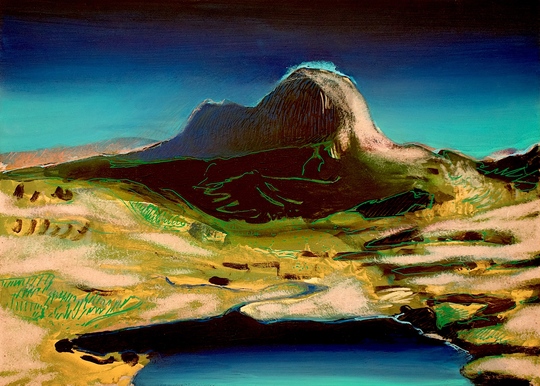
What are your new projects?
Artistically, after my extensive work on Scotland, it's still a bit of an unknown. But from a fishing point of view, a trip to the Highland lakes is in the pipeline for next spring. The fact that I'm going there, or rather "up there", by night train (the Caledonian Sleeper), adds a certain spice to the adventure in my eyes.




